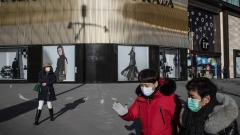Apr 8, 2020
A Road Trip to Prince Edward Island Is Just What the Doctor Ordered
, Bloomberg News
(Bloomberg) -- Here at Bloomberg Pursuits, we know most of your plans are on hold. Ours are, too! But that doesn’t mean we’re not daydreaming about the trips, meals, and other worldly delights that we’ll rush out to experience once it’s safe again to do so. We’re sharing our ideas with you in the hopes that they will help inspire you—and we’d love to hear what you’re daydreaming about, too. Send us your thoughts and plans at daydreams@bloomberg.net, and we’ll flesh some of them out for you in future versions of this column so we can help you make them a reality.
Anne of Greene Gables is a gay icon.
You may not know that about the star of the hallowed Lucy Maud Montgomery novels, who was famous for her charming misadventures in small-town Canada. Anne went on to be depicted in a number of movie and television adaptations that are treasured by young people of all stripes. Adopted by a gruff, aging brother-and-sister pair on Prince Edward Island, Canada, the poor young girl was always out of place in the quiet town of Avonlea. She was too flamboyant, too curious, her flaming red hair and personal theatrics always getting her in trouble.
To me, a shy, freckled preteen boy in Cape Elizabeth, Maine, she was my queer hero before I knew I was queer: a person who wanted life to be bigger and more romantic than it could ever be in a little town in the woods. Anne couldn’t hide who she was and didn’t want to. She was smart, inquisitive, and full of emotions, and she expected everyone else to be, too. From her, gay kids learned it wasn’t just OK to be different—it was something you could be proud of.
Plus, she had a love-interest-slash-worst-enemy in the figure of the dreamy, curly-haired Gilbert Blythe. Having a painful crush on a hot guy you hate is just about the gayest thing I can think of.
(Reader: She marries him!)
As the books went on, Anne’s antics grew to contain more fictional towns and forests on Prince Edward Island, and I’ve always intended to go there. It shares a lot in common with coastal Maine, where I grew up: rocky beaches and freezing water, handsome vestigial lighthouses, and tattered roads winding between ancient farm fields. Somewhere there’s a slate kitchen roof where Anne might have tried to perform a balancing act to show off for the town girls, only to fall off and sprain her ankle. (When her bosom friend Diana found her in the bushes, she shrieked: “Anne, are you killed?”) There are also century-old schoolhouses like the one where she and Gilbert flirted unknowingly as they fought to be first in class.
When social distancing is over, I’m not putting off this trip any longer. I’m going to drag my husband and see everything that Prince Edward Island has to offer, stuff my face with local seafood, and maybe go balance on a kitchen roof. Here’s the itinerary I’m currently daydreaming about.
Getting There
To get to Prince Edward Island you can fly into the capital, Charlottetown, on Delta or Air Canada, but I’d like to take our time and ride on a car ferry from Nova Scotia.
In my dream scenario, I’d get a fancy but comfortable car like the Porsche 911 Targa convertible I borrowed a couple of years ago to take my dad on a road trip along the Maine coast. But in reality it would probably be a Mazda 3 from Zipcar, which is my household’s actual preferred ride. Maybe we’ll get one in lipstick red in honor of Anne’s famous hair: sensible and efficient, but with a whisper of hey girl.
We’d start in Maine, scoot up from Portland and across the border to the picturesque port of St. John, the oldest incorporated city in Canada, to spend the night at a bed-and-breakfast like the Homeport Historic. Part of the fun of the trip would be experiencing the shoreline up to where the U.S. ends and Canada begins, into the elbow where New Brunswick and Nova Scotia meet. From St. John we’d drive through the postage-stamp-size towns along the northern coast of Nova Scotia to Pictou, where the ferry leaves for Prince Edward Island. The island is hidden across the Northumberland Strait to the north, and the weather is brisk. September is a nice time to go, with temperatures in the high 60s Fahrenheit and low 70s during the day.
Wood Ovens and Oysters
After getting the breeze and salt air in our hair for the 75-minute ferry ride (and maybe catching up on Anne of Windy Poplars), we’ll drive up the eastern coast to the rambling Inn at Bay Fortune, which we’ll make home base. It was once the summer house of the great stage and screen actress Colleen Dewhurst, who played Anne’s grumbling adoptive caretaker Marilla in the cherished Canadian TV series. Dewhurst, you gays, was a huge Broadway star and a legend at the Public Theater, winning two Tonys over her long career. She also won four Emmys, including two for playing Candice Bergen’s mom on Murphy Brown. Her home is hallowed ground.
Now it’s a 15-room inn overseen by chef Michael Smith, who uses the organic farm on the grounds to create 10-course feasts he calls “FireWorks.” The meals are served family-style at a long butcher block table, with everything from local fish to chowder to bread cooked from a roaring, 25-foot open outdoor brick oven. Before dinner, guests are invited to mingle over a locally brewed beer, including the refreshing Beach Chair lager or a low-alcohol After Hours grisette from Prince Edward Island Brewing Co. There are also mounds of fresh oysters—the world-famous Malpeques, meaty and bright, are farmed in the bay off the western shore of the island. My husband doesn’t eat seafood, so more for me.
Speaking of which, if we make it there between Sept. 17 and 20, the island is celebrating its annual Shellfish Festival, which will mark its 25th year this fall. There will be oyster shucking races, live music, a chowder competition, and a contest to see who can make the best boozy Caesar (a Canadian bloody mary).
Island Sights
P.E.I. is a great island for driving, and the local tourism bureau website has a bunch of advice on where to cruise around. The southern shore is called the Red Sands Shore because its beaches have (gasp) reddish sands. On our first day of exploration we’ll head down there, stopping in at the bustling Charlottetown along the way for some food. We’ll hunt down the little hidden-away Chip Shack, which sells apple fries, hot dogs, and a variety of poutines, including lobster poutine. Lobster poutine! Sadly, I’ll have to eat the whole thing by myself.
View this post on InstagramA post shared by Jason (@jase.c) on Jun 3, 2018 at 6:56pm PDT
And we’ll make time to stop for a cone of gooey mooey ice cream (burnt sugar ice cream, English toffee marble, caramel cups, and chocolate flakes) at Cow’s Creamery because we’re not insane.
At the far end of the island we’ll end our day at a cannot-miss: the Canadian Potato Museum. According to its own website, it’s one of the top 11 food museums in the world, “a living testament to the humble tuber and those who have tilled the soil in its evolution.” Tiny Prince Edward Island produces a full 25% of all of Canada’s potatoes, so the locals have something to be proud of! Highlights include “the world's largest exhibits of potato-related farm machinery, agricultural and community artifacts and the world’s largest potato sculpture.”
View this post on InstagramA post shared by Scott Molnar (@scott.a.molnar) on Oct 11, 2019 at 11:22am PDT
At Last, Anne
We’ll save the best part of the trip for last: a visit to the Green Gables, the farmhouse that inspired L.M. Montgomery while she was writing the books. On the way there we’ll cruise along the northern coast of the island, which features stunning views of sandstone cliffs and picture-perfect wooden lighthouses such as the ones at Covehead Harbour and North Rustico Harbour.
The actual Green Gables house in Cavendish was owned by the writer’s relatives the Macneills, and she explored the area around it often as a child. Montgomery has written that the setting gave rise to many locations in the books and that Cavendish along the sea is roughly the fictional town of Avonlea. The homestead is now in a large national park that was built up around Green Gables because of the site’s popularity. There’s plenty of parking for Porsches or Mazda 3s.
You can take a tour of the house, which is filled with period-appropriate late 19th century antiques. But the real fun, I think, would be to explore the grounds and see the inspiration for the “Balsam Trail,” “Lake of Shining Waters,” and “Haunted Woods” from Anne’s imagination. I’ve made it sound like I’d be dragging my husband around for this whole trip, but the truth is, he reads 10 times more than I do and grew up loving the Avonlea books just as much. I’m excited that we’ll both be able to see these places for the first time together.
There’s a moment in the books when Anne realizes she’s been at Green Gables for a year, and she has the following conversation with Marilla, her curmudgeonly caretaker who discovers that she has fallen in love with Anne in spite of herself:
“Do you remember what happened this day last year, Marilla?"
“No, I can't think of anything special.”
“Oh, Marilla, it was the day I came to Green Gables. I shall never forget it. It was the turning point in my life. Of course it wouldn’t seem so important to you. I’ve been here for a year and I’ve been so happy. Of course, I’ve had my troubles, but one can live down troubles. Are you sorry you kept me, Marilla?"
“No, I can’t say I’m sorry,” said Marilla, who sometimes wondered how she could have lived before Anne came to Green Gables. “No, not exactly sorry.”
Sometime, maybe about a year from now, it will be hard to remember exactly what it was like when we were all trapped inside, with only our books and TV shows and each other’s voices to entertain ourselves. But I’m hoping that even if we can’t conjure up exactly how it felt during this time, we will be able to appreciate how far we’ve come to get back to normal.
And I bet the feeling of gratitude will linger for all the people we’ll once again get to see up close. And thankfulness for the places—like Prince Edward Island or even just a friend’s house—we’re going to be able to go.
I know I’ll be grateful for lobster poutine.
A Footnote
Each of these “Daydream” columns is going to end with a charity or helpful initiative that the writer has chosen to support during the time of the Covid-19 crisis. While I was writing this, I made a donation to the Ali Forney Center for homeless LGBTQ+ youth in New York City. It’s a drop-in center and a network of homes for queer kids who have nowhere else to go, often because their families have kicked them out. Its staffers have agreed to potentially put themselves at risk so AFC can remain open during this time of isolation, because their teens and young adults need a safe and healthy place to go more than ever.
I’d like to think that Anne, one of the great orphans of literature and someone who has meant a great deal to many young gay people, would find it a fitting cause to support. And I hope you will, too.
©2020 Bloomberg L.P.


